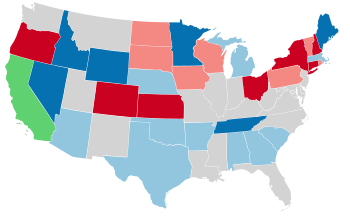The 1914 United States elections elected the members of the 64th United States Congress, occurring in the middle of Democratic President Woodrow Wilson's first term. Democrats retained control of both houses of Congress, the first time they were able to do so since the American Civil War (1861-1865).
| ← 1912 1913 1914 1915 1916 → Midterm elections | |
| Election day | November 3 |
|---|---|
| Incumbent president | Woodrow Wilson (Democratic) |
| Next Congress | 64th |
| Senate elections | |
| Overall control | Democratic hold |
| Seats contested | 33 of 96 seats (32 Class 3 seats + 3 special elections)[1] |
| Net seat change | Democratic +3 |
|
 | |
| 1914 Senate election results
Democratic gain Democratic hold | |
| House elections | |
| Overall control | Democratic hold |
| Seats contested | All 435 voting seats |
| Net seat change | Republican +62 |
 | |
| 1914 House of Representatives results | |
| Gubernatorial elections | |
| Seats contested | 31 |
| Net seat change | Republican +2 |
 | |
| 1914 gubernatorial election results
Democratic gain Democratic hold | |
Republicans won massive gains in the House, but Democrats maintained a solid majority in the chamber.[2]
In the first Senate election since the passage of the 17th Amendment, Democrats won small gains, maintaining control of the chamber.[3] This would also be the first of five times since the passage of the 17th amendment that the president's party gained Senate seats and lost House seats, something that would be repeated by Democrats in 1962 and 2022, and by Republicans in 1970 and 2018.
See also
editReferences
edit- ^ Two Class 3 seats held both a regularly-scheduled election and a special election in 1914. These seats are not double-counted for the total number of seats contested.
- ^ "Party Divisions of the House of Representatives". United States House of Representatives. Retrieved 25 June 2014.
- ^ "Party Division in the Senate, 1789-Present". United States Senate. Retrieved 25 June 2014.